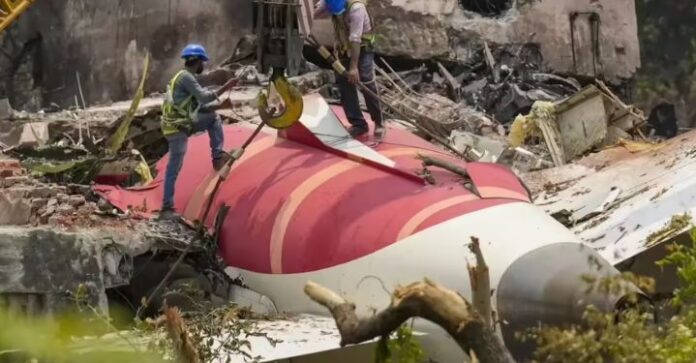The AAIB’s preliminary findings on the tragic Air India Flight AI 171 crash have offered key technical insights — but rather than providing closure, they’ve opened a Pandora’s box of unanswered questions. The accident, which killed 260 people, including those on the ground, has now been officially linked to an inexplicable simultaneous fuel shut-off of both engines shortly after takeoff from Ahmedabad.
This headline focuses on the ambiguity and unresolved factors, highlighting the growing concern among aviation experts, families, and international observers.
The Known Facts
According to the AAIB, within 15 seconds of liftoff, the fuel-control switches for both engines were somehow moved from “RUN” to “CUT-OFF”, causing a sudden loss of thrust. These switches are critical for engine operation — flipping them to CUT-OFF essentially starves the engine of fuel.
Data from the Flight Data Recorder (FDR) confirms that both engines lost power within one second of each other, initiating a cascading systems failure. The cockpit voice recorder (CVR) captured audible confusion between the pilots: “Why did you cut off?” “I didn’t do it.” These chilling exchanges suggest the crew themselves were unaware of how the switches were flipped.
A Mystery of Motion
Aircraft safety engineers and pilots have underscored that accidental activation of both switches is nearly impossible. The switches are spring-loaded, protected by mechanical guards, and require conscious effort to move. The notion that both were moved sequentially without intention has raised the possibility of one of three explanations:
- Intentional sabotage or human error
- A mechanical or electrical anomaly
- A systemic procedural lapse or training issue
None of these have been conclusively proven. This is the crux of the mystery.
What the AAIB Report Rules Out
- Fuel contamination: Laboratory testing of the aircraft’s fuel tanks, ground hydrants, and fueling trucks found no impurities.
- Bird strikes: No impact or ingestion was recorded. Engine blades showed no signs of bird or debris damage.
- Engine malfunction: The GE GEnx-1B engines did not exhibit pre-crash faults.
- Black box interference: Both the CVR and FDR were recovered intact and analyzed properly.
- Pilot suicide: No psychological red flags were found in either pilot’s background.
What the Report Raises
1. Mechanical Reliability of Switch Guards
A 2018 FAA Special Airworthiness Information Bulletin (SAIB) warned of potential wear or misalignment in the switch-locking mechanisms on Boeing 787s. However, the bulletin was non-mandatory, and Air India reportedly never performed the recommended inspection.
Could this be a long-ignored ticking time bomb? The AAIB has not yet examined whether the switch-locks in VT-ANB failed due to age, wear, or improper maintenance.
2. Cockpit Ergonomics and Human Factors
Why were the pilots seemingly unaware of the switches being moved? Was there a distraction, miscommunication, or lapse in checklist adherence? While the CVR transcript points to confusion, it doesn’t indicate clear accountability. Analysts believe that human-factors experts must now assess cockpit behavior, task saturation, and stress levels.
3. Sabotage or Malicious Interference
While authorities have been careful not to suggest foul play, India’s aviation minister has confirmed that a sabotage investigation is underway. This could include analysis of ground crew access, software intrusion, or even rogue cockpit behavior. However, no evidence supporting sabotage has been disclosed publicly.
Reactions from Aviation Community
- Pilot Associations have criticized the AAIB’s tone as subtly accusatory toward the flight crew. They argue the report lacks context, especially since the CVR is not fully transcribed or released.
- Air India has stated that it is fully cooperating and awaits the final report, expected in mid-2026.
- Aviation safety experts say the case is reminiscent of rare “control reversals” or unexplained mechanical anomalies in modern aircraft — an area that requires greater scrutiny and transparency.
Unanswered Questions That Still Haunt Investigators
| Question | Status |
|---|---|
| Who moved the switches — and why? | Unknown |
| Did the switch-lock guards fail? | Under investigation |
| Was there a software or avionics anomaly? | Not confirmed |
| Were FAA bulletins ignored systemically? | Possibly |
| Could this point to a larger issue in the 787 fleet? | Experts urge caution, but say further analysis needed |
Next Steps
The AAIB is expected to:
- Reconstruct the exact mechanical operation of both fuel-control switches.
- Re-interview ground personnel, maintenance engineers, and dispatchers.
- Analyze the recorded flight deck audio with behavioral experts.
- Examine switch guards on similar Boeing 787s in the Air India fleet.
- Coordinate with international authorities like the FAA and ICAO.
Conclusion
In the absence of a clear mechanical failure or human error explanation, the Air India 171 crash sits in a liminal space of speculation. The AAIB has ruled out many possibilities, but the core trigger — the fuel switch movements — remains unexplained.
Until that critical piece of the puzzle is resolved, passenger safety questions remain open, not just for Air India but for Boeing’s entire Dreamliner fleet.

